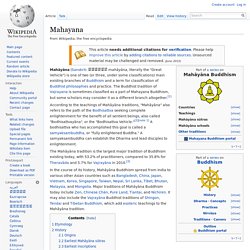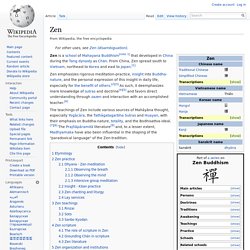

White Horse Temple. Do not confuse this pagoda with the White Horse Pagoda, Dunhuang.

White Horse Temple (simplified Chinese: 白马寺; traditional Chinese: 白馬寺; pinyin: Báimǎ Sì, Wade-Giles: Paima szu) is, according to tradition, the first Buddhist temple in China, established in 68 AD under the patronage of Emperor Ming in the Eastern Han capital Luoyang.[1][2][3] The site is located just outside the walls of the ancient Eastern Han capital, some 12–13 kilometres (7.5–8.1 mi) east of Luoyang in Henan Province.
Xuanzang. Xuanzang (Hsuan-tsang) (c. 602–664), born Chen Hui or Chen Yi (Chen I), was a Chinese Buddhist monk, scholar, traveller, and translator who described the interaction between China and India in the early Tang Dynasty.

Mahayana. Mahāyāna (Sanskrit: महायान mahāyāna, literally the "Great Vehicle") is one of two (or three, under some classifications) main existing branches of Buddhism and a term for classification of Buddhist philosophies and practice.

The Buddhist tradition of Vajrayana is sometimes classified as a part of Mahayana Buddhism, but some scholars may consider it as a different branch altogether.[1] According to the teachings of Mahāyāna traditions, "Mahāyāna" also refers to the path of the Bodhisattva seeking complete enlightenment for the benefit of all sentient beings, also called "Bodhisattvayāna", or the "Bodhisattva Vehicle. "[2][note 1] A bodhisattva who has accomplished this goal is called a samyaksaṃbuddha, or "fully enlightened Buddha.
" A samyaksaṃbuddha can establish the Dharma and lead disciples to enlightenment. The Mahāyāna tradition is the largest major tradition of Buddhism existing today, with 53.2% of practitioners, compared to 35.8% for Theravāda and 5.7% for Vajrayāna in 2010.[3] Zen. Zen is a school of Mahayana Buddhism[note 1] that developed in China during the Tang dynasty as Chán.

From China, Zen spread south to Vietnam, northeast to Korea and east to Japan. Zen emphasizes rigorous meditation-practice, insight into Buddha-nature, and the personal expression of this insight in daily life, especially for the benefit of others. As such, it deemphasizes mere knowledge of sutras and doctrine and favors direct understanding through zazen and interaction with an accomplished teacher.
Zen lineage charts. Zen lineage charts depict the transmission of the dharma from one generation to another.

They developed during the Tang Dynasty, incorporating elements from Indian Buddhism and East Asian Mahayana Buddhism, but were first published at the end of the Tang. History[edit] The idea of a patriarchal lineage in Ch'an dates back to the epitaph for Fărú (法如 638–689), a disciple of the 5th patriarch Hóngrĕn (弘忍 601–674). Bodhidharma. Bodhidharma was a Buddhist monk who lived during the 5th/6th century CE.

He is traditionally credited as the transmitter of Ch'an (Sanskrit: Dhyāna, Japanese: Zen) to China, and regarded as its first Chinese patriarch. According to Chinese legend, he also began the physical training of the Shaolin monks that led to the creation of Shaolinquan. Little contemporary biographical information on Bodhidharma is extant, and subsequent accounts became layered with legend.[1][note 1] The principal Chinese sources vary on their account of Bodhidharma's origins. [note 2] Aside from the Chinese accounts, several popular traditions also exist regarding Bodhidharma's origins. Chinese Chán. Chán (simplified Chinese: 禅; traditional Chinese: 禪, abbr. of chánnà (禪那), from Sanskrit dhyāna, meaning "meditation" or "meditative state") is a school of Mahāyāna Buddhism developed in China from the 6th century CE onwards, becoming dominant during the Tang and Song dynasties.

After the Song, Chán more or less fused with the Pure Land school. From China, Chán spread south to Vietnam and east to Korea (where it is known as Seon) and, in the 13th century, to Japan, where it became known as Zen. Nichiren Buddhism. Nichiren Buddhism (Japanese: 法華系仏教 Hokke-kei Bukkyo) is a branch of Buddhism based on the teachings of the 13th century Japanese monk Nichiren (1222–1282).

Nichiren Buddhism is generally noted for its focus on the Lotus Sutra and an attendant belief that all people have an innate Buddha nature and are therefore inherently capable of attaining enlightenment in their current form and present lifetime. It is also noted its opposition to other forms of Buddhism, which Nichiren saw as deviating from the Buddhist truth he had discovered. Nichiren Buddhism is a comprehensive term covering several major schools and many sub-schools, as well as several of Japan's new religions.
Its many denominations have in common a strong focus on the chanting and recital of said sutra, which is thought to hold "extraordinary power".[1] The founder, Nichiren[edit] Basic teachings[edit] Nichiren's writings[edit] Nichiren was a prolific writer. Pure Land Buddhism. Pure Land Buddhism (simplified Chinese: 净土宗; traditional Chinese: 淨土宗; pinyin: Jìngtǔzōng; Japanese: 浄土仏教[1], Jōdo bukkyō; Korean: 정토종, jeongtojong; Vietnamese: Tịnh Độ Tông), also referred to as Amidism[2][3] in English, is a broad branch of Mahāyāna Buddhism and one of the most widely practiced traditions of Buddhism in East Asia.

Pure Land is a tradition of Buddhist teachings that are focused on Amitābha Buddha. Tiantai.